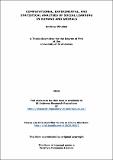Files in this item
Computational, experimental, and statistical analyses of social learning in humans and animals
Item metadata
| dc.contributor.advisor | Laland, Kevin N. | |
| dc.contributor.author | Whalen, Andrew | |
| dc.coverage.spatial | xii, 199 p. | en_US |
| dc.date.accessioned | 2016-05-18T15:36:03Z | |
| dc.date.available | 2016-05-18T15:36:03Z | |
| dc.date.issued | 2016-07-22 | |
| dc.identifier | uk.bl.ethos.687020 | |
| dc.identifier.uri | https://hdl.handle.net/10023/8822 | |
| dc.description.abstract | Social learning is ubiquitous among animals and humans and is thought to be critical to the widespread success of humans and to the development and evolution of human culture. Evolutionary theory, however, suggests that social learning alone may not be adaptive but that individuals may need to be selective in who and how they copy others. One of the key findings of these evolutionary models (reviewed in Chapter 1) is that social information may be widely adaptive if individuals are able to combine social and asocial sources of information together strategically. However, up until this point the focus of theoretic models has been on the population level consequences of different social learning strategies, and not on how individuals combine social and asocial information on specific tasks. In Chapter 2 I carry out an analysis of how animal learners might incorporate social information into a reinforcement learning framework and find that even limited, low-fidelity copying of actions in an action sequence may combine with asocial learning to result in high fidelity transmission of entire action sequences. In Chapter 3 I describe a series of experiments that find that human learners flexibly use a conformity biased learning strategy to learn from multiple demonstrators depending on demonstrator accuracy, either indicated by environmental cues or past experience with these demonstrators. The chapter reveals close quantitative and qualitative matches between participant's performance and a Bayesian model of social learning. In both Chapters 2 and 3 I find, consistent with previous evolutionary findings, that by combining social and asocial sources of information together individuals are able to learn about the world effectively. Exploring how animals use social learning experimentally can be a substantially more difficult task than exploring human social learning. In Chapter 4, I develop and present a refined version of Network Based Diffusion analysis to provide a statistical framework for inferring social learning mechanisms from animal diffusion experiments. In Chapter 5 I move from examining the effects of social learning at an individual level to examining their population level outcomes and provide an analysis of how fine-grained population structure may alter the spread of novel behaviours through a population. I find that although a learner's social learning strategy and the learnability of a novel behaviour strongly impact how likely the behaviour is to spread through the population, fine grained population structure plays a much smaller role. In Chapter 6 I summarize the results of this thesis, and provide suggestions for future work to understand how individuals, humans and other animals alike, use social information. | en_US |
| dc.language.iso | en | en_US |
| dc.publisher | University of St Andrews | |
| dc.rights | Attribution-NonCommercial-NoDerivatives 4.0 International | * |
| dc.rights.uri | http://creativecommons.org/licenses/by-nc-nd/4.0/ | * |
| dc.subject | Social learning | en_US |
| dc.subject | Bayesian models | en_US |
| dc.subject.lcc | QL785.W5 | |
| dc.subject.lcsh | Social learning | en_US |
| dc.subject.lcsh | Learning in animals | en_US |
| dc.subject.lcsh | Bayesian statistical decision theory | en_US |
| dc.title | Computational, experimental, and statistical analyses of social learning in humans and animals | en_US |
| dc.type | Thesis | en_US |
| dc.type.qualificationlevel | Doctoral | en_US |
| dc.type.qualificationname | PhD Doctor of Philosophy | en_US |
| dc.publisher.institution | The University of St Andrews | en_US |
The following licence files are associated with this item:
This item appears in the following Collection(s)
Except where otherwise noted within the work, this item's licence for re-use is described as Attribution-NonCommercial-NoDerivatives 4.0 International
Items in the St Andrews Research Repository are protected by copyright, with all rights reserved, unless otherwise indicated.


